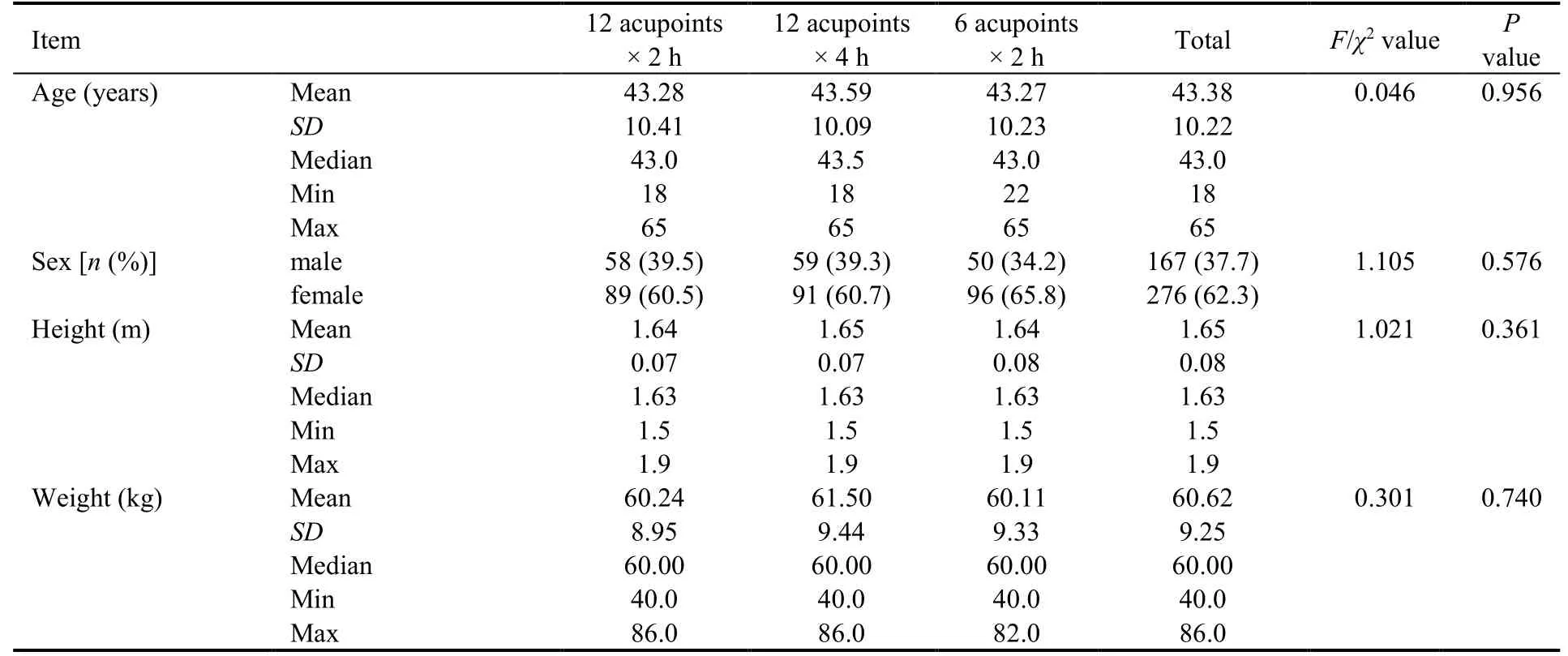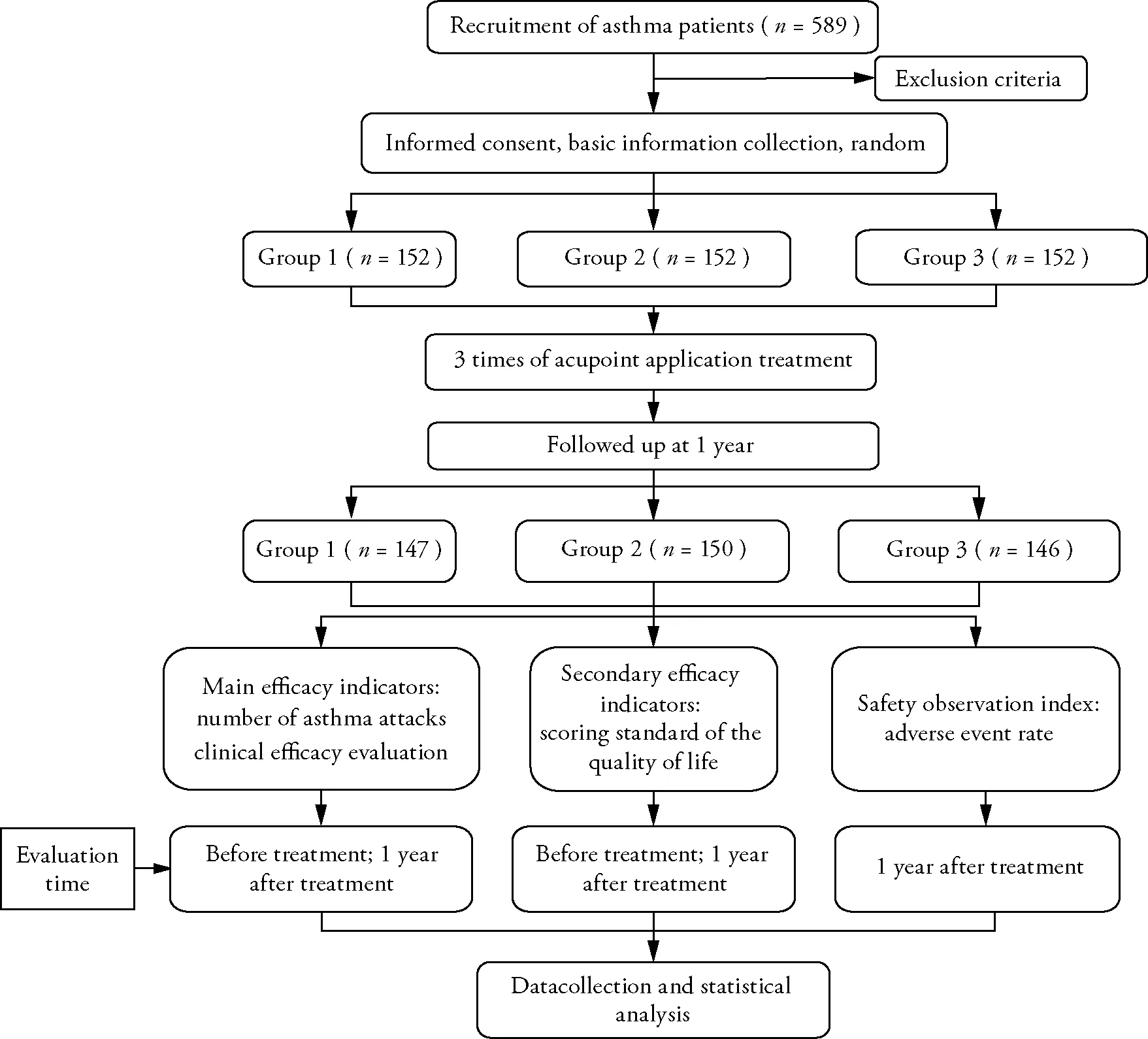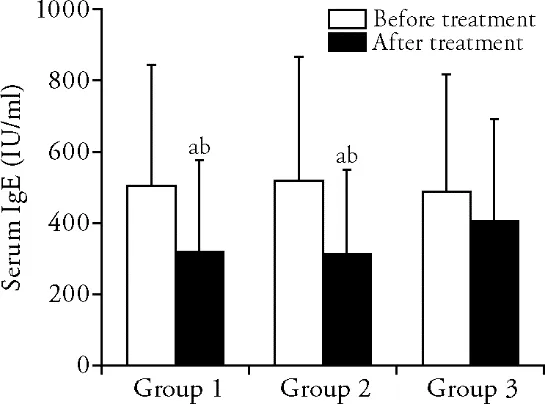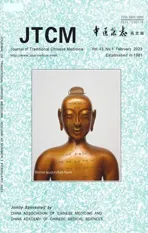Long-term efficacy of point application therapy on different acupoints and durations in the treatment of asthma: a randomized controlled trial
2023-02-15JINYutongWULingtaoGUOYangluXIAChongYUBinyanXUANLihua
JIN Yutong,WU Lingtao,GUO Yanglu,XIA Chong,YU Binyan,XUAN Lihua
JIN Yutong,GUO Yanglu,YU Binyan,XUAN Lihua,Department of Acupuncture and Moxibustion,the First Affiliated Hospital of Zhejiang Chinese Medical University (Zhejiang Provincial Hospital of Chinese Medicine),Hangzhou 310006,China
WU Lingtao,Department of Massage,Hangzhou Fuyang Hospital of Traditional Chinese Medicine,Hangzhou 311400,China
XIA Chong,Department of Acupuncture and Moxibustion,Hangzhou Fuyang Hospital of TCM Orthopedics and Traumatology,Hangzhou 311400,China
Abstract OBJECTIVE: To optimise point application therapy for the treatment of asthma.METHODS: A total of 456 patients with asthma were randomly divided into treatment groups 1,2,and 3,with 152 patients each.The Dazhui (GV14),Feishu (BL13),Xinshu (BL15),Geshu (BL17),Pishu (BL20),Shenshu(BL23),and Guanyuan (CV4) acupoints were selected for treatment groups 1 and 2,with 2 and 4 h of application,respectively.The Feishu (BL13),Xinshu (BL15),and Geshu (BL17) acupoints were selected in group 3,with 2 h of application.All patients underwent application of the“prevention of disease” plaster during the dog days of summer (approximately July and August each year)between 2015 and 2019.RESULTS: The analysis showed that the numbers of asthma attacks and total serum immunoglobulin E (IgE)levels of the three groups after treatment were significantly lower than those before treatment.In addition,the reductions in treatment groups 1 and 2 were more significant than those in group 3.The total treatment efficacy rates and post-treatment quality of life scores of the patients in treatment groups 1 and 2 were significantly higher than those in group 3.CONCLUSIONS: Point application therapy can effectively improve the clinical symptoms of patients with asthma,reduce the number of attacks,improve the quality of life,and decrease the total serum IgE level.The choice of acupuncture points,but not the length of the application time,influenced the therapeutic effect of point application therapy in asthma.
Keywords: point application therapy;asthma;dog days of summer;randomized controlled trial
1.INTRODUCTION
Asthma is a chronic inflammatory disease characterised by airway hyperresponsiveness and reversible airway obstruction.The disease course is divided into the acute attack period and chronic remission period according to the frequency or intensity of asthma attacks.The symptoms of the acute attack period primarily include wheezing,shortness of breath,chest tightness,and cough.1According to the Global Initiative for Asthma Committee,approximately 300 million patients have asthma worldwide,and in recent years,there has been a surge in the incidence of asthma.2,3China has become one of the countries with the highest asthma fatality rates worldwide.4
The Western medications currently recommended by national and international asthma guidelines can quickly control the acute exacerbation of asthma.However,these are not ideal for reducing the attacks during the chronic remission period and improving the quality of life of patients with asthma in terms of safety and long-term efficacy.5-8
Point application therapy,as a traditional TCM external therapy,has a significant effect on the preventing and treating asthma.A large number of studies have shown that point application therapy can effectively control the attack of asthma and reduce the recurrence rate and control the long-term symptoms of asthma.9-14However,research evidence on the clinical efficacy of asthma with different acupoints and application duration is still insufficient.
This study considered the application of different acupoints and durations,with applications on the Dazhui(GV14),Feishu (BL13),Xinshu (BL15),Geshu (BL17),Pishu (BL20),Shenshu (BL23),and Guanyuan (CV4)acupoints for 2 h and 4 h,and applications on Feishu(BL13),Xinshu (BL15),and Geshu (BL17) acupoints for 2 h as the investigational factors in patients with asthma.Three groups of applications of differing durations (12 acupoints × 2 h,12 acupoints × 4 h,and six acupoints ×2 h) were established to investigate the efficacy of application on different acupoints with various durations.The parameters measured included the number of attacks,improvement in the clinical symptoms,quality of life,and serum immunoglobulin E (IgE) levels of patients with asthma in remission.
2.METHODS
This study was designed as a multi-centre,before-andafter trial,which was registered with the Chinese Clinical Trial Registry (Registration No.ChiCTR2100048256).This study was performed according to the guidelines and principles of the Declaration of Helsinki.Ethics approval for this trial was granted by the Ethics Committee of The First Affiliated Hospital of Zhejiang Chinese Medical University (approval No.2015-KL-010-02).All participants provided a voluntary written informed consent form after a full discussion regarding the potential benefits and risks of the study before participation.
2.1.Sample size calculation
According to pre-experimental research results,in the treatment of bronchial asthma,the effective rate for the group of applying six acupoints × 2 h in winter disease and summer treatment was 70%.The effective rate for the group of applying 12 acupoints × 2 h and 12 acupoints × 4 h in the winter treatment and summer treatment groups were equal and 85%.Under the conditions of α=0.05 and test power 1-β=0.8,we calculated 121 study participants for each group.Due to loss rate and other factors,the sample size was expanded by 20%,and eventually,152 study participants were determined,equal to a total of 456 cases.This was calculated as follows:

2.2.Participants
Data from four-level A tertiary hospitals,including Zhejiang Provincial Hospital of Chinese Medicine,Zhejiang Hospital,the First Affiliated Hospital of Wenzhou Medical University,and Ningbo Hospital of Traditional Chinese Medicine,were used in this study.A total of 456 patients who met the diagnostic criteria for asthma and visited the outpatient clinics of any one of these hospitals were enrolled between 2015 and 2019.
2.3.Baseline condition
The patients were divided into treatment groups 1 (12 acupoints × 2 h),2 (12 acupoints × 4 h),and 3 (six acupoints × 2 h) with simple randomization using a random number table in a ratio of 1:1:1,with 152 patients in each group.When comparing the age,gender,height,and weight of the included cases in the three groups,there was no statistically significant difference between the groups (P> 0.05),indicating that the groups were comparable and the baseline was balanced (Table 1).The course of bronchial asthma among the included case groups was compared,and there was no statistically significant difference between the groups (P> 0.05),idicating the groups were comparable,and the baseline was balanced (Table 2).In the included cases,the comparison of the number of attacks between the baseline groups wasP> 0.05,indicating no statistically significant difference between the groups,the groups were comparable,and the baseline was balanced (Table 3).Therefore,the groups are comparable,and the baseline characteristics are balanced.

Table 1 Baseline characteristics

Table 2 Course of bronchial asthma baseline

Table 3 Baseline comparison of asthma attacks
2.4.Diagnostic criteria
According to the “Guidelines for the Prevention and Management of Bronchial Asthma” formulated by the Asthma Group of Chinese Society of Respiratory Diseases,Chinese Medical Association,15the typical clinical symptoms and signs of asthma include the following: (a) repeated episodes of wheezing and shortness of breath,with or without chest tightness or cough,that frequently occur at night and in the morning,and are often related to exposure to allergens,cold air,physical and chemical irritations,upper respiratory tract infections,and exercise;(b) scattered or diffuse wheezing in both lungs on auscultation,with a prolonged expiratory phase during the attack;and (c) the abovementioned signs and symptoms could be relieved spontaneously or after treatment.The variable expiratory airflow limitation was confirmed using the following objective tests: (a) positive bronchodilator reversibility test,(b) positive bronchial challenge test,and (c) average daily diurnal peak expiratory flow (PEF) variability > 10%or weekly PEF variability > 20%.The diagnosis of asthma was made when the above-mentioned criteria were met with one positive test for airflow limitation after ruling out other diseases that can also present with wheezing,chest tightness,and cough.
2.5.Staging standard
The clinical course of asthma can be divided into theacute attack stage,chronic persistent stage,and clinical remission stage,based on the clinical manifestations.An acute asthma attack refers to the sudden onset of symptoms,such as wheezing,shortness of breath,cough,and chest tightness or the exacerbation of the original symptoms;this diagnostic criteria refer to “Guidelines for Prevention and Treatment of Bronchial Asthma”.This stage is characterised by the decrease in expiratory airflow,which is often caused by exposure to allergens,irritants,or respiratory infections.Chronic remission refers to the manifestation of symptoms,such as wheezing,shortness of breath,chest tightness,and cough at different frequencies and/or intensities every week.
2.6.Inclusion criteria
The inclusion criteria for this study were as follows: (a)patients who were diagnosed according to the abovementioned diagnostic criteria and were not in the acute attack period;(b) patients in the remission period of asthma according to the standard of traditional Chinese medical syndrome differentiation;(c) patients not taking other immunostimulants,inhaled corticosteroids,or other drugs during treatment or patients not taking shortterm inhaled corticosteroids (< 1 month per year);(d)patients aged 18-65 years;and (e) patients who provided written informed consent and were willing to be compliant with the study protocol.
2.7.Exclusion criteria
The exclusion criteria for this study were as follows: (a)patients with other diseases that can cause wheezing or dyspnoea;(b) pregnant or breastfeeding women;(c)patients hypersensitive to the prescription drugs in this study;(d) patients who could not participate in this study because of heart failure,moderate to severe hypertension,diabetes mellitus,hematological diseases,or mental illnesses;(e) patients with scar constitution or history of tape sensitivity;(f) patients with unhealed exposed wounds in the point application therapy area;or (g)patients with other diseases that were not suitable for point application therapy.
2.8.Discontinuation and withdrawal standards
The participants were withdrawn from the study in the event of any of the following: (a) patients who had not completed the prescribed course of treatment;(b)patients who were lost to follow-up due to various reasons,such as going abroad and relocation;(c) patients who developed a serious adverse event,patients who requested to discontinue the study due to the adverse event,or patients who needed to discontinue the study due to the adverse event as judged by the trial operator;(d) patients who had a systemic disease that had not been detected before the commencement of the study;(e)patients taking medications that would affect the results of the study during the treatment or the follow-up observation period after treatment;or (f) patients who died by force majeure,such as vehicular accidents and other accidents.
2.9.Treatments
2.9.1.Groups
2.9.1.1.Treatment group 1 (12 acupoints × 2 h)
Medication components: the medication was composed of Baijiezi (Semen Sinapis),Yanhusuo (Rhizoma Corydalis Yanhusuo),Gansui (Radix Kansui),Xixin(Herba Asari Mandshurici),and Bingpian(Borneolum Syntheticum)with a dosage ratio of 1∶1∶0.5∶0.5∶0.1.Paste preparation: the above drugs were mixed,crushed,and blended with ginger juice.Subsequently,Bingpian(Borneolum Syntheticum) and a small amount of petroleum jelly (Vaseline) as an excipient were added,and the mixture was set aside for later use.
Selected acupoints: the selected acupoints for this treatment group were Dazhui (GV14),Feishu (BL13),Xinshu (BL15),Geshu (BL17),Pishu (BL20),Shenshu(BL23),and Guanyuan (CV4).
Applicationmethod: five grams of the paste,which was made into a medicinal cake measuring approximately 1× 1 cm,was applied to each acupoint mentioned above and fixed in place with adhesive tape at each appointment during the first 10 d of the dog days of summer every year.The application was repeated once after 10 and 20 d (applied three times a year).Point application therapy lasted for 2 h in each session.
2.9.1.2.Treatment group 2 (12 acupoints × 4 h)
The medication components,paste preparation,and selected acupoints were the same as in treatment group 1.Application method: the application lasted for 4 h at each session,and the rest of the application protocol was the same as treatment group 1.
2.9.1.3.Treatment group 3 (6 acupoints × 2 h)
The medication components and preparation of the paste were the same as in treatment group 1.
2.9.2.Selected acupoints
The selected acupoints for this treatment group were Feishu (BL13),Xinshu (BL15),and Geshu (BL17).The method of point application therapy showed in Figure 1.All patients in the three groups were treated with point application therapy during the dog days of summer between 2015 and 2019 and followed up 1 year after treatment to record the symptoms and retest serum IgE levels.

Figure 1 Herbal acupoint sticking method
2.10.Efficacy evaluation
2.10.1 Primary endpoints
Number of asthma attacks: the number of asthma attacks 1 year before point application therapy and the number of asthma attacks during the corresponding period after point application therapy were recorded to calculate the number of asthma attacks within 1 year in each patient.One attack was counted if an emergency medication was needed to alleviate symptoms.
Clinical efficacy evaluation: according to the standards of the “Evidence-based clinical practice guidelines of acupuncture and moxibustion: Bronchial asthma in adults”16(draft) published by the Chinese Acupuncture and Moxibustion Association,clinical remission was defined as the absence of the requirement for any antiasthmatic drugs and an asymptomatic state for > 1 year.Significant effectiveness was defined as the occasional requirement of anti-asthmatic drugs to relieve wheezing.Effectiveness was defined as the alleviation of wheezing symptoms but still with the need for medication from time to time,or a prolonged remission period with decreased number of attacks and shortened duration of the attacks.Ineffectiveness was defined as no evident improvement in symptoms.
2.10.2.Secondary endpoints Scoring standard of the quality of life: the “Adult Asthma Quality of Life Questionnaire” 17 contains a total of 37 questions,which are divided into six domains,including activity limitation (questions 1-7),avoidance of irritants(questions 8-12),asthma symptoms (questions 13-22),psychological and emotional functions (questions 23-28),responses to stimuli (questions 29-33),and worries about the disease (questions 34-37).The questionnaire is scored on a 5-point scale,where 1 indicates the worst and 5 indicates the best.The questionnaire was answered separately before and after treatment,and the score was obtained by adding the points for each item.
Laboratory endpoint: thepatients’ total serum IgE levels were tested quantitatively before and after treatment.Before treatment and one year after treatment,2 mL of blood was taken from the patients,and the First Affiliated Hospital of Zhejiang Chinese Medical University laboratory department used the enzymelinked immunosorbent assay (ELISA) method to detect the serum IgE content of the patients.(Reagent: IgE ELISA kit;Instrument: Microplate reader,etc.)
2.10.3.Safety evaluation
Safety: adverse events during the implementation of the project,such as infection and other reactions,were recorded and evaluated.
Possible skin reactions and treatment measures after application: after application,the local skin becomes reddish or pigmented,and mild itching is a normal reaction.If skin redness and small blisters appear,they generally heal on their own.If the skin is red,swollen,and blistered,a topical solution can be applied.
2.11.Statistical analysis
The Statistical Package for the SAS (vers 8.2,SAS Institute,Chicago,IL,USA) software was used for the statistical analysis of data.The measurement data are expressed as the mean ± standard deviation ().The pairedt-test and variance analysis were performed for normally distributed data,while the non-parametric test was performed for data without normal distribution.The enumeration data are expressed as the number of cases(n) and percentage or rate (%),and comparisons between the groups were performed using theχ2test.The twosided test was used for all statistical tests,andP-values <0.05 were considered statistically significant.
3.RESULTS
The treatment was initiated during the dog days of summer.Treatment groups 1,2,and 3 were composed of 147 (five dropouts due to change of mobile phone numbers resulting in loss of communication),150 (two dropouts due to large blisters prompting discontinuation),and 146 patients (six dropouts due to work commitments conflicting with the study),respectively,who were included in the final analysis (Figure 2).
3.1.Comparisons of the number of asthma attacks before and after treatment in each group
The numbers of attacks before treatment among the three groups were comparable with no significant differences(P> 0.05).However,the numbers of asthma attacks were significantly lower at 1 year after treatment with point application therapy than those before treatment in each group (P< 0.05).The intergroup comparisons also showed that the numbers of attacks after treatment in treatment groups 1 were significantly lower than that in treatment groups 2 and 3 (P< 0.05) (Table 4).
3.2.Comparisons of the total clinical efficacy rate after treatment among the three groups of patients with asthma
The total clinical efficacy rates in treatment groups 1 were significantly higher than that in treatment group 3(P< 0.05) 1 year after treatment with point application therapys during the canicular days.There was no statistically significant difference between treatment groups 1 and 2 (P> 0.05).The addition of the Dazhui(GV14),Pishu (BL20),Shenshu (BL23),and Guanyuan(CV4) acupoints for application significantly improved the total clinical efficacy rate of point application therapy(Table 5).
3.3.Comparisons of quality of life scores among groups of patients with asthma
The quality of life scores of patients in treatment group 1 and group 2 were significantly higher than those in treatment group 3 (P< 0.05) 1 year after treatment,indicating that the quality of life of patients with asthma in treatment groups 1 improved more significantly after treatment than that in patients in treatment group 3 (Figure 3).No statistically significant difference was observed between treatment groups 1 and 2 (P> 0.05).
3.4.Comparisons of total serum immunoglobulin E levels before and after treatment in each group of patients with asthma
The total serum IgE levels among the three groups before treatment were comparable with no significant differences (P> 0.05).The total serum IgE levels obtained 1 year after treatment were significantly lower than those before treatment (P< 0.05).After treatment,the intergroup comparisons revealed a greater decrease in treatment group 1 and group 2 than in treatment group 3 (Figure 4).

Figure 2 Technology roadmap

Figure 3 Comparisons of the quality of life scores before and after treatment in each group of patients with asthma

Figure 4 Comparisons of serum immunoglobulin E levels before and after treatment in each group of patients with asthma
3.5.Safety evaluation
No severe adverse events occurred during the entire treatment and observation period,except for large blisters,skin rupture,and itchiness in a few patients(Table 6).Patients with relatively larger and ruptured blisters were instructed to visit the hospital for treatment.After the skin was disinfected with iodophor,the liquid in the blisters was drawn out using a syringe,and the wounds were treated with topical application of gentian violet and covered with gauze.Patients with ulcerated skin were advised to use iodophor for disinfection.Patients with itchy skin and small blisters were advised to avoid scratching the affected area and wait for the blisters to be absorbed naturally.
Table 4 Comparisons of the number of attacks before and after treatment in each group of patients with asthma (n,)

Table 4 Comparisons of the number of attacks before and after treatment in each group of patients with asthma (n,)
Notes: treatment group 1: 12 acupoints × 2 h;treatment group 2: 12 acupoints × 4 h;treatment group 3: 6 acupoints × 2 h.Compared to before treatment,aP < 0.05;after treatment,compared to treatment group 3,bP < 0.05;after treatment,compared with treatment group 2,cP < 0.05.
Table 5 Comparisons of the total clinical efficacy rate after treatment amon g groups of patients with asthma ()

Table 5 Comparisons of the total clinical efficacy rate after treatment amon g groups of patients with asthma ()
Notes: treatment group 1: 12 acupoints × 2 h;Treatment group 2:12 acupoints × 4 h;treatment group 3: 6 acupoints × 2 h.After treatment,compared with treatment group 3,aP < 0.05.
Table 6 Adverse event rate ()

Table 6 Adverse event rate ()
Notes: Treatment group 1: 12 acupoints × 2 h;Treatment group 2:12 acupoints × 4 h;Treatment group 3: 6 acupoints × 2 h.
4.DISCUSSION
Asthma has long been recorded in Traditional Chinese Medicine and was known as “Xiaobing” in ancient times.According to the tenets of Traditional Chinese Medicine,asthma is caused by the abiding retention of phlegm in the lungs in conjunction with other factors,such as external contraction,diet,emotions,and fatigue,leading to airway blockage with phlegm and the lung qi ascending counterflow.The pathological changes underlying the attack include the trigger of the “abiding phlegm” due to the external contraction,which rises withQi,and is blocked by phlegm,leading to mutual fight andtangling,airway blockage,pulmonary tube stenosis with poor patency,and abnormal reduction of the pulmonaryQi.These changes induce phlegm stagnation,causing severe wheezing and shortness of breath.In the remission period,due to the long-term repeated attacks,cold phlegm injures the spleenYang,and phlegm heat consumes and burns the lungYinand kidneyYin,leading to the conversion from excessive symptoms to asthenic symptoms,which usually manifest as deficiency of the lung,spleen,and kidney.18
Modern medicine characterises asthma as a chronic airway inflammatory disease involving various cells and cellular components,whose main pathological changes include inflammation and airway remodelling.19,20Various guidelines recommend the administration of glucocorticoids,β-receptor blockers,and sublingual immunotherapy for the treatment of asthma;however,the safety and long-term efficacy of these treatments are extremely limited.7,8
Point application therapy,which is an external therapeutic modality used in Traditional Chinese Medicine,is highly valuable due to its dual functions as medication and acupoint.This technique is convenient to use,inexpensive,safe,and lacks side effects,and is thus favoured by several individuals.21In recent years,a few clinical randomised controlled trials have proven that point application therapy during the remission period can significantly improve the clinical symptoms,anxiety,and quality of life of patients with asthma.12However,studies on the combination of different acupoints and duration of application are still lacking.
In the current study,the traditional Chinese drug,Bingpian (Borneolum Syntheticum),and Vaseline were added based on the original prescription of “Zhang Shi Yi Tong” to reduce skin irritation caused by the topical drugs and enhance their efficacy by virtue of the enhanced percutaneous penetration effect of Bingpian(Borneolum Syntheticum).The “prevention of disease”plaster with a national invention patent was prepared with Baijiezi (Semen Sinapis),Yanhusuo (Rhizoma Corydalis Yanhusuo),Gansui (Radix Kansui),Xixin(Herba Asari Mandshurici),and Bingpian (Borneolum Syntheticum).22Raw Baijiezi (Semen sinapis) is pungent and warm and enter the lung meridian,which can promoteQi,relieve phlegm,warm an individual in the middle of the night,and dispel cold.Yanhusuo (Rhizoma Corydalis Yanhusuo) is pungent,bitter,and warm and can promote blood circulation and regulateQi.Gansui(Radix Kansui)enters the lung meridian,removes phlegm,and expels excessive fluid.Xixin (Herba Asari Mandshurici) is pungent and warm and relieves the exterior syndrome and dispels cold,warms the lungs,and resolves fluid stagnation.Thus,a combination of all these substances could produce the effects of warming the lungs,expelling phlegm,and resolving fluid stagnation.
The number of attacks within a year and clinical efficacy evaluation were used as the primary endpoints in this study,while the quality of life score and total serum IgE levels were used as the secondary endpoints.The effects of various combinations of acupoints with different application durations in patients with asthma were compared to optimise the application strategy.The results showed that application on different acupoints with different durations can effectively reduce the number of asthma attacks,improve the clinical efficacy and the quality of life of patients,and reduce serum IgE levels,which serve as an allergy index.The intergroup comparisons revealed that the efficacy of the 12-acupoint group was better than that of the six-acupoint group,and there was no statistically significant difference in the clinical efficacy,quality of life,and allergy index between the two 12-acupoint groups with different application durations.There is no interaction effect between sticking acupoints and sticking durations.In this study,the 12-acupoint group added the Pishu (BL20),Shenshu (BL23),Dazhui (GV14),and Guanyuan (CV4)acupoints,which were absent from the six-acupoint group,suggesting that the long-term repeated attacks of asthma induced dysfunction of the lung,spleen,and kidney.Consequently,enhancing the nourishment of the spleenQiand kidneyQibased on the replenishment of lungQicontributes significantly to the improvement in long-term efficacy.
In summary,this study optimised the selection of acupoints and application duration for the treatment of asthma with point application therapy.It was concluded that the application on Dazhui (GV14),Feishu (BL13),Xinshu (BL15),Geshu (BL17),Pishu (BL20),Shenshu(BL23),and Guanyuan (CV4) acupoints for 2 h could significantly improve the clinical symptoms and the quality of life in patients with asthma.Further in-depth studies are required to improve the other point application therapy therapies and explore the mechanisms of different application therapies.
5.ACKNOWLEDGEMENTS
We would like to express our gratitude to the First Affiliated Hospital of Zhejiang Chinese Medical University for their cooperation in the ethics review and participant recruitment.
We also appreciate the cooperation of the participants in this trial.
杂志排行
Journal of Traditional Chinese Medicine的其它文章
- Effects of the Huangkui capsule (黄葵胶囊) on chronic kidney disease: a systematic review and Meta-analysis
- Effectiveness of moxibustion alone on lumbar disc herniation: a Meta-analysis of randomized controlled trials
- Efficacy of acupuncture therapy for post-stroke fatigue: a systematic review and Meta-analysis
- Efficacy of luteolin on the human gastric cancer cell line MKN45 and underlying mechanism
- Tilianin extracted from Xiangqinglan (Herba Dracocephali Moldovicae) inhibits apoptosis induced by mitochondrial pathway and endoplasmic reticulum stress in H9c2 cells after oxygenglucose deprivation/reoxygenation
- Comparing the effects of three decoctions for coronavirus disease 2019 on severe acute respiratory syndrome coronavirus 2-related tolllike receptors-mediated inflammations
